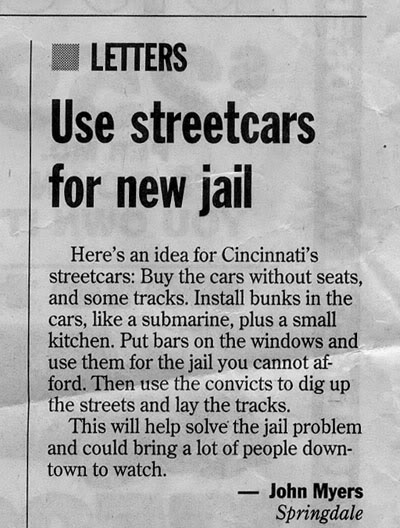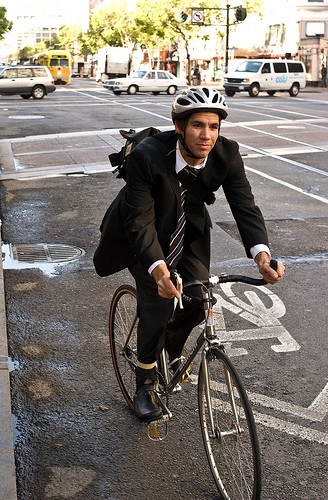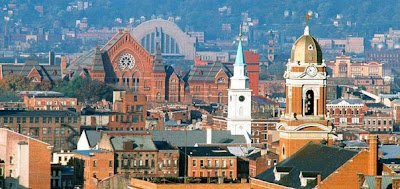 Today the Virginia-based Cincinnati Enquirer has published yet another hit piece on the proposed Cincinnati Streetcar project. The Gannett-owned newspaper sponsored a telephone survey of 600 adults in Cincinnati between Tuesday, May 18 and Wednesday, May 19. The survey concluded that those who plan on riding the modern streetcar system were in support of the project, while 61% said that they were opposed to borrowing $64 million to build the initial system.
Today the Virginia-based Cincinnati Enquirer has published yet another hit piece on the proposed Cincinnati Streetcar project. The Gannett-owned newspaper sponsored a telephone survey of 600 adults in Cincinnati between Tuesday, May 18 and Wednesday, May 19. The survey concluded that those who plan on riding the modern streetcar system were in support of the project, while 61% said that they were opposed to borrowing $64 million to build the initial system.
Now I could go on and on about the survey itself and about how telephone surveys are historically unreliable and undercount certain demographics, or about how borrowing money is par for the course in any local-level expenditure even though the survey presented it differently, or about how the Enquirer decided to use one of their patented misleading and sensationalist headlines for the story on their sponsored survey, but I won’t.
Instead I want to look at the disturbing trend that the Enquirer has of putting down the city to appeal to their suburban audiences. Through the middle of May, the Enquirer has ran 56 negative letters to the editor and just three positive letters on the Cincinnati Streetcar. Tom Callinan, Editor and Vice President of Content for the Cincinnati Enquirer, stated that these letters are simply representative of what is sent in, and that the Enquirer simply “takes what you send.” Interesting, because I find it hard to believe that the disparity is that great, but I digress.
The coverage goes much farther than the outlandish publishing of anti-streetcar letters to the editor and includes editorials from Mr. Callinan himself that either directly bemoan the project or passively attack it. The daily beat coverage of the topic has also been fairly skewed to appeal to these anti-streetcar readers in the suburbs. Why is this the case though? Why does the Enquirer feel the need to criticize and attack the city while boosting the suburbs in the region?

The answer to that may lie in the conversation I had with a content editor at the Enquirer three years ago where he said, “We tell the stories our readership wants to hear.” Encouraging right? The Enquirer does not care about providing fair/balanced news coverage, they care only about their bottom line and telling the story they feel their readers want to hear.
At that time when I spoke with the content editor, not Mr. Callinan, the Enquirer had made a focused moved towards Cincinnati’s northern suburbs where the population growth was/is occurring, and where they felt they might be able to pick up new readers in the increasingly merging Cincinnati-Dayton metroplex. And by no coincidence, it was around this time that I started UrbanCincy to start sharing the good stories happening in the city that the Enquirer cared not to share with its audience.
Since that time UrbanCincy has flourished beyond what I ever thought it would become. Thousands of readers come to the site weekly to stay plugged in with what’s happening in Cincinnati’s urban core, and get news on things that quite frankly are not either covered in the Enquirer, or barely at all. I do not take joy in this, nor do I make any kind of profit from this website, but I do find it telling that the readership continues to grow as more and more people get fed up with the Enquirer’s anti-city bias. It does not have to be this way, but the Enquirer has chosen their side, and that is the side of the suburbs. I truly wish there was not a need for a site like UrbanCincy as I would much prefer the daily print newspaper to cover these issues.
Going forward, UrbanCincy will no longer link to the Enquirer and I would like to encourage you to no longer buy the print edition, cancel your subscription if you have one, and even quit visiting their website. If Mr. Callinan and the content managers want to position themselves against the city, and only exploit it to their suburban audience’s delight, then they should go right ahead, but those of us that love this city should make them aware we do not approve by hitting them where it counts – their pocket book.
If you feel so motivated to write the Enquirer so that they can simply “take what you send them” and have it published, you can do so by emailing letters@enquirer.com, sending your letters to “Letters, Enquirer Editorial Page, 312 Elm Street, Cincinnati, OH 45202,” or by fax at (513) 768-8569. You must include your name, address (including community) and daytime phone number. Also please limit your letters to 100 words or less.




